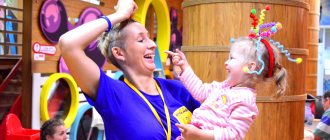An important indicator of the intelligence of a preschooler is the development of speech at the age of 5-6 years. At this age, the child knows 3000-4000 words and pronounces most of the sounds correctly. Children are able to construct detailed phrases and give detailed descriptions. To improve pronunciation and develop vocabulary, didactic games, finger and articulation gymnastics are used.
The speech development of a 4-5 year old child is very important.
Features of speech development in children aged 5-6 years
If parents and teachers pay enough attention to the child’s development, his speech by the age of 6 is not much different from that of an adult. This further affects learning in primary school.
At the sixth year of life, the child is fluent in intonation. He is able to learn and read a poem joyfully or sadly. Depending on the situation, the preschooler changes the volume of his voice and speed of speech, and can speak in a whisper.
At this age, children learn:
- generalizations;
- terms that have multiple meanings;
- division into syllables;
- different shades of meaning.
At the request of an adult, the child can easily find the name of an object starting with a given letter and highlight the necessary sounds at the beginning and end.
Lexicon
At the age of 5-6 years, the active vocabulary normally ranges from 3 to 4 thousand words. The child can choose generalizing names for a group of homogeneous nouns.
ъHis vocabulary includes:
- nouns - names of professions, organizations, etc.;
- adjectives - complex shades of colors, materials from which objects are made, other characteristics;
- Verbs;
- adverbs.
The stock of knowledge includes not only visible objects, but also abstract concepts - feelings and relationships of people, natural phenomena, etc.
The quality of pronunciation also improves with age. The child no longer confuses sounds, replaces or misses them in well-known words. Errors are possible only in long terms unfamiliar to the child.
Children enjoy playing rhymes and composing poems. They like “reversals” - comic works with a rearrangement of meaning - “a village was driving past a peasant...”.
Language grammar
At the age of 5-6 years, the child gives a complete and detailed answer to the question. At the same time, the topic of conversation should be well known to him. Children use simple, short phrases in everyday conversations. Gradually the length of the sentences increases. More descriptive elements appear in speech, enhancing brightness and expressiveness - adjectives, participles, adverbs.
If you tell a child a fairy tale or read a story, he can already identify the main idea of the text and the essential features of individual objects and phenomena. A preschooler is able to determine the cause-and-effect relationships of phenomena and their time dependence. He easily compares the characteristics of objects and phenomena: size, shape, location in space.
In most cases, a preschooler uses words in a sentence in the correct form. Sometimes erroneous forms are allowed - teddy bears, no pencils, etc.
The number of common and complex sentences in a child’s speech is constantly increasing. At this time, he begins to notice shortcomings in his own and other people's speech.
Factors in the development of grammar.
At this age, children love the following games:
- find another name for an object or the opposite word (search for synonyms and antonyms);
- a noun and its attribute - what is tall, round, etc.;
- recognize the item by description.
Sound pronunciation
By the age of 6, the speech apparatus completes its formation. At this time, children pronounce most sounds correctly. However, pronunciation deficiencies still occur. The most common of them:
- replacement of the sound L or its loss: maako (milk), vozhka (spoon), soldering (stick);
- softening hard L - palka (stick);
- replacing the sound R with L or Y - bows (hands), dyka (hole);
- complete loss of P - baan (ram), kaova (cow)
- unclear pronunciation of hissing sounds, replacing them with whistling sounds.
The cause of the disorders may be developmental defects:
- shortening of the frenulum of the tongue;
- malocclusion;
- the sky is too high.
If the main sounds do not appear on their own before the age of 5, you need to contact a specialist. The speech therapist will examine the child and tell you what to do to improve diction.
A common problem at this age is hesitation or stuttering. These disorders occur in children whose thoughts cannot keep up with their speech. Preschoolers with a weak type of nervous activity are susceptible to stuttering. A provoking factor can be excessive strictness of adults in the family, or less often in kindergarten. Sometimes a child begins to stutter if there is an adult in the family with the same problem. Then the five-year-old simply imitates the speech of another family member.
Connected speech
At the age of 5-6 years, it is extremely difficult to give exact parameters for the development of coherent speech. Some children can give detailed, detailed answers to any question.
They skillfully use intonation and come up with fairy tales and stories on their own. The speech of others is emotionally poor, inexpressive, with a meager vocabulary. This happens more often with children whose development is neglected.
By the age of six, a child is able to:
- Make up a short story based on the picture.
- Retell a text you read or listened to.
- Talk about an excursion, a visit to a museum or a children's performance.
- Retell the content of the cartoon and share your impressions.
- Choose the most accurate and vivid epithets to describe your feelings.
Speech development is negatively affected by excessive involvement with the computer or other devices. Electronic games primarily use the visual analyzer. At the same time, hearing and speech slow down in development. As a result, the child is unable to coherently express his thoughts. To avoid learning problems, parents should limit the time a preschooler spends on a computer or smartphone.
Diagnosis of speech disorders
To identify speech disorders in children 5-6 years old, ask:
- Describe the action of the person or object in the picture. For example: what is the eagle doing? (flies). What is the girl doing? (combs his hair).
- Indicate the action opposite to that named by the speech therapist: “lay down - stood up”, “ran - stood”, as well as the antonym of the proposed sign: “cheerful - sad, slow - fast”.
- Say what the baby of this or that animal is called. For example: a cat has a kitten, a fox has a little fox, a dog has a puppy, an elephant has a baby elephant.
- Name the shape and color of the drawn figure (triangle, circle, oval, square).
- Describe the item. “What kind of chair?” - “Soft, cozy, warm, with wooden armrests, gray, large.”
- Take a toy that lies ON the table, UNDER the stool, IN the drawer, IN FRONT of the bag, BEHIND the book, BETWEEN the chairs. This allows you to determine whether the baby understands prepositions correctly.
- Convert singular to plural. One nightingale - two nightingales, one drop - three drops, one village - five villages.
- Change the noun by case. What? Bed. Shall I lie on what? Beds. Made what? Bed. Pushed towards what? To the bed. I'll tell you what? About the bed.
- Agree verb and noun according to gender. The cat came into the kitchen. How about a cat? The cat came into the kitchen.
- Name what is shown in the pictures. For this task, pictures are selected in the same color scheme. Red fish, red cherry, red jacket, red flower.
- Repeat difficult words after the speech therapist: excavator, electricity, perestroika, shipwreck, propeller. The baby repeats each word 2-3 times. And the specialist monitors whether the child rearranges syllables, replaces or skips sounds, and whether the stress is placed correctly.
Norm of child speech development between the ages of 5 and 6 years
Norms of child speech development.
For a child aged five to six years, the following indicators of speech development are considered normal:
- Quick memorization of poems and fairy tales.
- Speaking out the actions and thoughts of toys.
- Correct pronunciation of all sounds, including complex ones.
- Ability to speak with expression, speeding up or slowing down, loudly or in a whisper.
- Speech without grammatical errors. It is possible that the stress may be placed incorrectly in complex unfamiliar terms or the form of the noun may be incorrect. If a mistake is pointed out to a child, in the future he will speak correctly.
- Detailed answers to questions from adults.
- Ability to create a story based on a picture. Independent composition of the beginning or end of a story, fairy tales and short stories.
- Describing objects and guessing the name from another person's story.
Sometimes the child makes mistakes when declension of nouns by case, or uses prepositions incorrectly. This is acceptable for children under 6 years of age. Speech reserve and the general level of lexical development during this period largely depend on the efforts of parents and teachers. A child with whom they study, read books, speaks almost like an adult.
Sample activities:
I would like to note that the set of classes on the site is not complete and is for informational purposes only. If you want to get full a set of game activities for speech development for children 5-7 years old then write by email or feedback mail.
A set of game activities for speech development for children aged 5-7 years is presented in a Word document in black and white. This is very convenient, because... The training material can be easily printed and modified if desired.
Speech development exercises for practicing at home
It is best to develop a child’s speech at 5 years old through reading. It is useful to memorize poems, proverbs and sayings, solve riddles and read nursery rhymes. It is important that the child finds what is read to him interesting and understandable. The meaning of new words, sayings and popular expressions needs to be explained.
Children always copy the pronunciation and intonation of adults. In order for a child to speak correctly, parents must monitor the quality of their own speech - correctly place stress, inflect nouns, etc. The child’s vocabulary also depends on that of the parents. It is useful to observe natural phenomena together and discuss what is happening, read books and come up with entertaining stories together.
Didactic games
You can increase your preschooler’s vocabulary by playing entertaining games:
- Select antonyms and synonyms. An adult names a word, and the child first comes up with a word that is similar in meaning, and then the opposite.
- What kinds of objects are there? You can invite your child to think about what kind of cup there is (white, red, big, small, round, tall, wide, etc.). The same task can be created for adjectives - what is sweet (sweets, tea, pear).
- The adult names the characteristics of the object, and the child guesses from the description what it is about (round, red, sweet, edible, juicy - an apple).
- Training in declensions in numbers and cases (one apple - many apples, a cat sitting - cats sitting).
Thematic sets of pictures are used for development. You can show your child several cards, from which you need to choose one extra one (sparrow, magpie, swallow, dog). It is necessary for the child to explain his choice.
Didactic game for children 5-6 years old.
Didactic games can be carried out in a group of children. To do this you will need a ball or any soft toy. An adult names a generalizing concept (birds). Children take turns naming the birds they know and passing the ball around in a circle. The one who could not name the bird leaves the circle.
A child can be taught to compose coherent sentences from words arranged in random order. An adult calls them randomly (sparrow, branch, sits, on), children compose a ready-made phrase (sparrow sits on a branch).
Development of phonemic hearing
Phonemic hearing is the ability to recognize sounds (phonemes), i.e.:
- identify this or that sound by ear;
- distinguish different concepts that have the same phonemes (cat - current);
- distinguish similar names in which one sound is different (spoon - cat);
- establish the order of sounds in words.
Development of phonetic hearing.
To develop this skill in preschool children, games and exercises are used:
- What did it sound like? An adult puts several sounding toys on the table. It could be a pipe, bell, rattle, drum, etc. The child is allowed to touch and listen to what sounds each object makes. Then he turns away and determines by ear what it sounds.
- Find out by voice. The child turns his back and guesses which family member called him. First, the caller says the name. Then the game becomes more complicated - instead of the name, a short sound signal is pronounced - hey, hey.
- Definition of onomatopoeia - the child must understand what animal the speaker is imitating (imitation of a dog barking, a cat meowing, a cow mooing, etc.)
During the process, the speaker can change the timbre of his voice, volume and intonation.
Finger gymnastics
Exercises for the fingers are carried out in the form of a game and are accompanied by funny rhymes or songs. A light massage is performed first. First, stroke and rub each child’s finger from tip to base, then massage the entire hand. First, the adult does this himself, then you can teach the child to self-massage his hands.
The following exercises are performed:
- Flexion and extension of fingers. First, the adult shows how to perform the movement. Then watches the preschooler perform it independently.
- Static charging - use your fingers and hands to depict any animals or objects: a dog, a bird, a hare, a pistol, etc. You can show your child the tasks on your own hands or let them look at a card with a picture.
- An adult reads a short poem, while the child’s hands “stage” its content. This type of gymnastics combines static and dynamic exercises - objects or characters are depicted with the help of brushes and their action is conveyed.
To improve coordination and fine motor skills, you can perform simple exercises:
- rolling objects of different sizes between fingers;
- picking up pencils or sticks from the table with one hand;
- modeling;
- lacing;
- drawing and coloring pictures;
- weaving from wire or thread.
- stringing beads on wire or cord.
Thanks to such activities, the muscles of the hands develop. This stimulates the speech apparatus and intellectual development of the preschooler.
Articulation gymnastics
There are sets of exercises for the development of the speech apparatus of children.
You can improve the pronunciation of hissing and whistling sounds with the help of speech therapy gymnastics:
- “Fence” - the child bares his teeth and holds his lips in a smile for up to 10 seconds.
- “Stroke” - on a count from 1 to 10, stretch out your lips with a tube and hold it in this state.
- “Fence-tube” - the position of the lips alternates for 10 seconds.
- “Window” - the lips are held in a smile, while the mouth calmly opens and closes.
- Relaxation of the tongue muscles - the child is asked to smile and open his mouth slightly. The tongue needs to be relaxed, made wide and placed on the lower lip. Lightly slapping your outstretched tongue with your lips, pronounce the sounds “five-five-five” for 5 seconds.
- “Spatula” - relax your tongue and hold it in a calm state for 5-10 seconds.
- “Football player” - stretch out your lips with a tube and blow on a ball of paper or cotton wool, driving it into a “gate” of 2 cubes. There is no need to puff out your cheeks. The distance to the gate gradually increases.
Articulation gymnastics.
If a child speaks the sound P poorly, additional exercises are performed:
- “Painter” - the tongue rises, stretching the hyoid ligament. Open your mouth slightly in a smile, stroke the hard palate with the tip of your tongue from front to back. The tongue does not peek out from behind the teeth.
- “Brushing your teeth” - run the tip of your tongue along the inside of your upper teeth. Keep your mouth slightly open.
- “Mushroom” - open your mouth wide, make your tongue wide and stick its back to the roof of your mouth.
In addition to training individual sounds, exercises are performed to improve breathing.
Prevention of speech delay
The formation of a senior preschooler’s perfect speech is influenced by his living conditions, the characteristics of his parents’ upbringing style, and, most importantly, the efforts of caring adults. To avoid finding yourself on the threshold of school in a situation where a child has discovered numerous speech disorders and there is no time to correct them, you need to take care in advance of the harmonious development of the child’s speech.
To solve this problem, close communication between children and adults is of great importance. Walking together, doing creative work, looking at book illustrations with a parallel discussion of what they saw and felt. This work will give a powerful impetus to the development of the baby’s speech. It is very valuable to learn and use such rich material as counting rhymes, tongue twisters, poems, riddles, sayings, nursery rhymes, and proverbs. All words that children do not understand need to be explained and ensure that they are used correctly.
Reading children's literature should be accompanied by a conversation about the actions of the characters and an explanation of incomprehensible words. When memorizing poetic works, it is very useful to replenish a child’s vocabulary by drawing his attention to the figures of speech used by the author. “A dark forest that covered itself with a wonderful hat...” “What hat did the poet write about?” “And fell asleep under her quietly, soundly...” “Do you think the forest can fall asleep?” “How do you understand the word restlessly?”
In order to fully prepare for schooling, a child of five to six years old must be able to coherently express his thoughts and construct logical, complete statements. It is important to correct deficiencies in sound pronunciation in a timely manner, to teach children to use their voice and means of expression. If children receive a lot of positive information from the outside world and from fiction that they can discuss with adults, this greatly stimulates children's speech development.
When you need help
Reacting with a smile to words
Experts assure that you can understand what problems may arise in speech almost from birth:
- if by the end of 1 month the baby does not try to let him know by screaming that it is time for him to eat, or when he experiences discomfort;
- if at the end of 4 months he does not respond with a smile;
- if by the end of the fifth month he does not make individual sounds, pointing with his gaze at the object he means. For example, mom asks: “Where is the rattle?”;
- by the end of the 7th month does not try to attract attention with the help of spoken sounds;
- at the end of the 9th month, words consisting of repeated syllables, such as “ma-ma”, “pa-pa”, did not appear in the baby’s vocabulary;
- at 12 months does not respond to simple requests: “Give me a toy.”
Types of speech defects
Before you start classes, you need to know the types of speech disorders:
- stuttering;
- dyslalia;
- nasality;
- neurological diseases.
For your information! To identify them, you just need to regularly communicate with your child.
Exercises to correct the pronunciation of the sound [р]
Basic characteristics of speech at 5-6 years old
By this time, speech develops and becomes more complex. The baby is already able to make hissing and whistling sounds. The expressiveness of speech increases, you can notice this when reading poetry and in role-playing games. It becomes coherent and sentences become more common. Children are already able to retell a fairy tale or describe a picture.









